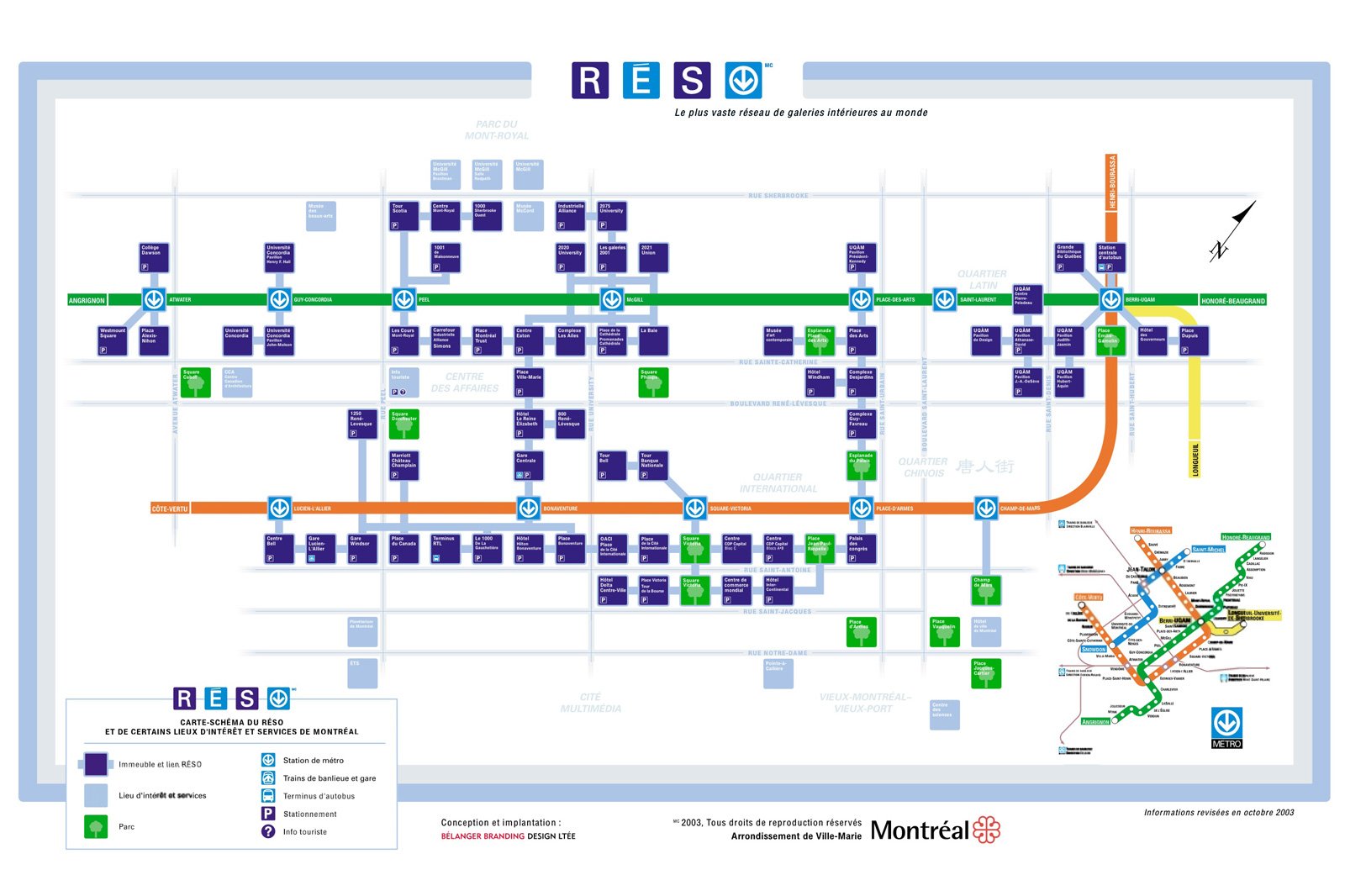Montreal’s Underground City (French: La Ville Souterraine;), officially called the RÉSO consists of interconnected complexes, both above and below ground, connected by a pedestrian network of over 33 km beneath downtown Montreal. The Underground City and its tunnels connect nearly 1,700 boutiques, 200 restaurants, universities, movie theatres, apartments, metro stations, art centers, museums, arena and more. Although it is called the underground city, it is actually a collection of interconnected complexes above and below ground around downtown Montreal. Montreal’s Underground City goes by many names:
- The Underground City
- La Ville Souteraine (French for : the underground city)
- Underground Pedestrian Network
- Ville intérieure (French for : the indoor city)
- RÉSO
Originally called the Underground City, it was rebranded as RÉSO in 2004. The name RÉSO is a homonym for the French word réseau, which means network. The name is quite fitting since RÉSO truly is a network of so many aspects of Montreal connected together. Much of Montreal’s identity and culture can be linked to the Underground City. The RÉSO underground system runs under Montreal’s largest commercial districts connecting some of the largest buildings, hotels, theatres, exhibition halls, restaurants, and more. It is the largest underground network in the world, incorporating everything from the Metro, which was built in 1966 in time for Expo ’67, to various boutiques and restaurants. Some of the important features of the Underground City include:
- Shopping malls such as the Eaton Centre, Les Cours Mont-Royal, Place Bonaventure, Promenades des Cathédrales, Place Montreal Trust, and Place Ville-Marie
- Place Bonaventure and the year-round ice skating rink
- Cultural and entertainment venues such as museums, movie theatres and exhibition halls, including Place des Arts, and the Palais des Congrès Convention Center
- Sports complexes, including the Bell Centre and the Olympic Stadium
- Hotels, condominium complexes, apartment buildings
- Transportation options, including the Montreal Metro system, two commuter train stations and a regional bus terminal
- Universities and colleges
- Restaurants and cafés
The Underground system first began to take shape in 1962 when Place Ville Marie was built. At the time, it was Montreal’s most modern skyscraper and a lower level shopping mall was a part of the project. It slowly expanded when the Metro was built in 1966, in time for Expo ’67. More subterranean malls began appearing and tunnels adjoined the subway stations with important locations around the city including office buildings and hotels. Today, RÉSO is its own indoor city with over 33 kilometers (20.5 miles) of tunnels. It is connected to over 200 restaurants, 1700 boutiques and shops, 30 movie theatres, 10 major hotels, 10 Metro stations, 10 university pavilions, banks, museums, Place Bonaventure, Palais des Congrès de Montréal, and the Bell Centre.
The Underground City is a convenient way to get around Montreal, regardless of the weather. It’s always cool in the summer, warm in winter and it never rains or snows. During the summer months, when it is too hot or humid, or during the winter months, when the frigid cold, snow, and ice invade the city, Montreal’s Underground City provides the perfect place to get away from it all. People often use the Underground City solely as a means of getting somewhere. There are 10 metro stations that are connected to the underground city.
As the Underground City developed its own identity, architects and urban planners developed unique public squares throughout the network. These squares were designed to create a warmer, friendlier atmosphere. Various areas of the Underground City tunnels are also filled with permanent artwork. Additionally, every year during the “Art Souterrain” event, portions of the RÉSO network are turned into temporary art galleries where a multitude of artists display their work.
Every day, approximately 500,000 people pass through the RÉSO network. It is one of the largest underground complexes in the world. There are over 120 exterior access points to the Underground City and it is comprised of over 60 residential or commercial complexes along with 12 square kilometers (4.6 sq mi) of connected areas. The underground city has 3.6 square kilometers of floor space, which includes 80% of all office space and 35% of all commercial space in downtown Montreal. Architecturally and technically considered tunnels, the Underground City is air conditioned with excellent lighting. Some of the tunnels or corridors are large enough to have shops on both sides. You can view a map of the Underground City here.






























Pingback: 5 Reasons Montreal Should Be At The Top of Your List of Destinations - Newscult
Pingback: Exploring underneath Montreal – Baggage Room
Pingback: La cittadina australiana dove si vive sottoterra - Il Post
Millie
December 31, 2024 at 7:47 pm
What time does Montréal Underground City close?